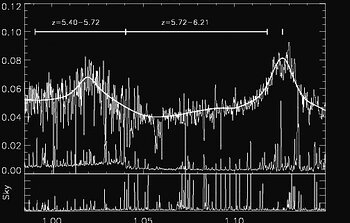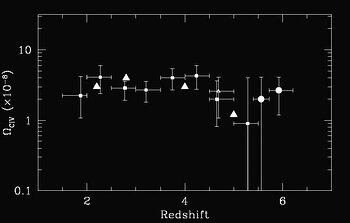Distant carbon atoms betray very early enrichment in the young universe
October 31, 2006

Robert A. Simcoe of the MIT-Kavli Center for Astrophysics and Space Research has found new evidence of intensive heavy-element enrichment in intergalactic gas, occurring less than 1 billion years (Gyr) after the Big Bang. His discovery of a high concentration of carbon atoms in the spectra of two very distant quasars implies that vigorous star formation was already underway in some neighborhoods when the universe was only 7% of its present age.
Charting the evolution of the carbon abundance is like taking a core sample of the early universe's stellar content. Since carbon nuclei are created through fusion in stellar cores, one would expect their abundance to decline at early times, approaching the formation epoch of the first stars. Simcoe's new observations show that the level of triply ionized carbon (i.e. carbon which has been stripped of three electrons, usually denoted as C IV) remains surprisingly constant as far as redshift z ~ 6. In other words, there is no evidence for a downturn in the integrated C IV abundance, even at the most distant and earliest epochs where it has now been measured.
Simcoe conducted infrared observations of the C IV spectral regions in two high redshift quasars-SDSS1306+0356 (zem = 6.002) and SDSS1030+0524 (zem = 6.272)-using the Gemini Near Infra Red Spectrograph (GNIRS) at Gemini South (Figure 1). Infrared spectrographs are essential for studying C IV absorption at z > 5, because the relevant transitions move from the optical to the infrared spectral domain. For this reason, GNIRS is a uniquely suited instrument for exploring the z ~ 6 universe and beyond.
Although the telescope was trained on the distant quasars for these observations, the actual C IV atoms under scrutiny belong to intervening gas between the quasar and Earth. These back-lit intervening clouds absorb photons from the more distant quasars, and the strength of absorption reveals the concentration of C IV at each redshift. Simcoe measured nine C IV absorption line systems between z = 5.72 and z = 6.21.
The constancy of the C IV density throughout most of the history of the universe is surprising, especially at z ~ 6 (Figure 2). Computer simulations predict that the mass density of C IV should start to turn down at these times, in contrast to what Simcoe observes.
Recent cosmic microwave background measurements indicate that light from the very first stars began to fill intergalactic space around z ~ 11-425 million years after the Big Bang. The time elapsed between z ~ 11 and z ~ 6 (where the C IV is now seen), lasted only 500 million years, barely long enough to form galaxies. This suggests that the galaxies that formed at z ~6 -10 may have been among the very first to produce the heavy elements found throughout the intergalactic medium today. The z ~ 6 CIV measurements show that they must have done so extremely vigorously and efficiently.
For more details, see the article "High Redshift Intergalactic C IV Abundance Measurements form the Near-Infrared Spectra of Two z ~ 6 QSOs", by Robert A. Simcoe, The Astrophysical Journal, in press.

